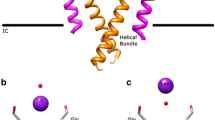Abstract
Ca2+-activated maxi K+ channels were studied in inside-out patches from smooth muscle cells isolated from either porcine coronary arteries or guinea-pig urinary bladder. As described by Groschner et al. (Pflügers Arch 417:517, 1990), channel activity (NP o) was stimulated by 3 μM [Ca2+]c (1 mM Ca-EGTA adjusted to a calculated pCa of 5.5) and was suppressed by the addition of 1 mM Na2ATP. The following results suggest that suppression of NP o by Na2ATP is due to Ca2+ chelation and hence reduction of [Ca2+]c and reduced Ca2+ activation of the channel. The effect was absent when Mg ATP was used instead of Na2ATP. The effect was diminished by increasing the [EGTA] from 1 to 10 mM. The effect was absent when [Ca2+]c was buffered with 10 mM HDTA (apparent pK Ca 5.58) instead of EGTA (pK Ca 6.8). A Ca2+-sensitive electrode system indicated that 1 mM Na2ATP reduced [Ca2+]c in 1 mM Ca-EGTA from 3 μM to 1.4 μM. Na2ATP, Na2GTP, Li4AMP-PNP and NaADP reduced measured [Ca2+]c in parallel with their suppression of NP o. After the Na2ATP-induced reduction of [Ca2+]c was re-adjusted by adding either CaCl2 or MgCl2, the effect of Na2ATP on NP o disappeared. In vivo, intracellular [Mg2+] exceeds free [ATP4−], hence ATP modulation of maxi K+ channels due to Ca2+ chelation is without biological relevance.
Similar content being viewed by others
References
Amman D, Morf WE, Anker P, Meier PC, Pretsch E, Simon W (1983) Neutral carrier based ion-selective electrodes. Ion Selective Electrode Rev 5:3–92
Bers DM (1982) A simple method for the accurate determination of free [Ca] in Ca-EGTA solutions. Am J Physiol 242:C404–408
Edwards G, Weston AN (1990) Potassium channel openers and vascular smooth muscle relaxation. Pharm Ther 48:237–253
Fabiato A (1988) Computer program for calculating total from specified free or free from specified total ionic concentrations in aqueous solutions containing multiple metals and ligands. In: Fleischer S, Fleischer B (eds) Methods in enzymology. Biomembranes, vol 157. ATP-driven pumps and related transport. Academic Press, Orlando, pp 378–416
Gelband CH, Lodge NJ, Breemen C van (1989) A Ca2+ activated K+ channel from rabbit aorta: modulation by chromakalim. Eur J Pharmacol 167:201–210
Gelband CH, Silberberg SD, Groschner K, Breemen C van (1990) ATP inhibits smooth muscle Ca2+ -activated K+ channels. Proc R Soc Lond Biol 242:23–28
Groschner K, Silberberg SD, Gelband CH, Breemen C van (1991) Ca2+ -activated K+ channels in airway smooth muscle are inhibited by cytoplasmic adenosine triphosphate. Pflügers Arch 417:517–522
Haylett DG, Jenkinson DH (1990) Calcium activated potassium channels. In: Cook NS, Quast U (eds) Potassium channels. Structure, classification, function and therapeutic potential. Ellis Horwood, Chichester, pp 70–95
Klöckner U, Isenberg G (1985) Action potentials and net membrane currents of isolated smooth muscle cells (urinary bladder of the guinea-pig). Pflügers Arch 404:329–339
Klöckner U, Isenberg G (1991) Endothelin depolarizes myocytes from porcine coronary and human mesenteric arteries through a Ca-activated chloride current. Pflügers Arch 418:168–175
Klöckner U, Trieschmann U, Isenberg G (1989) Modulation of calcium and potassium channels in isolated vascular smooth muscle cells. Drug Res 39:120–126
Marks PW, Maxfield FR (1991) Preparation of solutions with free calcium concentration in the nanomolar range using 1,2bis(o-aminophenoxy)ethane-N,N,N′,N′-tetraacetic acid. Anal Biochem 193:61–71
Martell A, Smith RM (1974) Critical stability constants, vol 1. Plenum Press, New York
Silberberg SD, Breemen C van (1990) An ATP, calcium and voltage sensitive potassium channel in porcine coronary artery smooth muscle cells. Biochem Biophys Res Commun 172:517–522
Standen NB, Quayle JM, Davies NW, Brayden JE, Huang Y, Nelson MT (1989) Hyperpolarizing vasodilators activate ATP-sensitive K+ channels in arterial smooth muscle. Science 245:177–180
Trube G, Isenberg G (1981) Determination of the Ca-EGTA apparent binding constant with a calcium electrode (abstract). Pflügers Arch 391:R58
Author information
Authors and Affiliations
Rights and permissions
About this article
Cite this article
Klöckner, U., Isenberg, G. ATP suppresses activity of Ca2+ -activated K+ channels by Ca2+ chelation. Pflugers Arch. 420, 101–105 (1992). https://doi.org/10.1007/BF00378648
Received:
Revised:
Accepted:
Issue Date:
DOI: https://doi.org/10.1007/BF00378648




